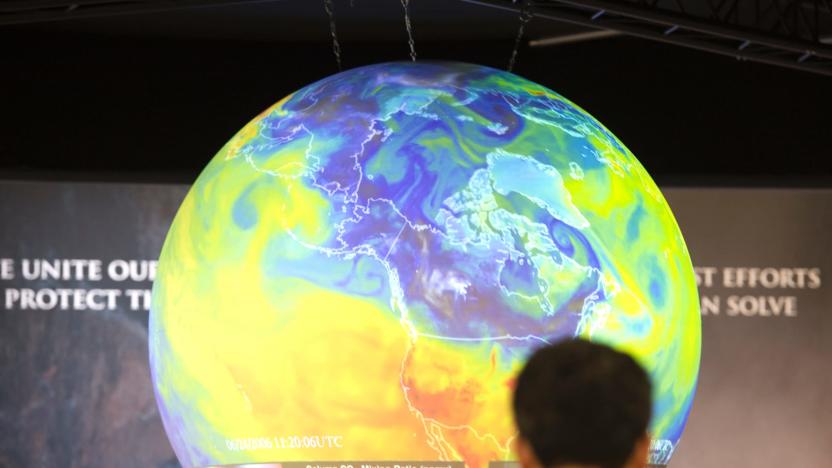climatechange
Latest

NASA's flying methane meter built for Mars finds work on Earth
Just as new military technologies often trickle down to civilian uses, a high-tech methane detector originally developed to detect gases on Mars has found a new role here on Earth. NASA's Jet Propulsion Lab built the the Open Path Laser Spectrometer (OPLS) and have affixed it to a standard quadcopter. And given that greenhouse gas emissions are currently at a 30-year high, according to the UN, this pipeline inspector can't come soon enough.

Commercial aircraft get their first global emissions standard
Ground-based vehicles have had emissions standards for a while (just ask Volkswagen), but commercial aircraft like passenger jets? Not so much. However, the world just took one big step toward cleaning up the skies: a total of 23 countries have agreed to set the first international carbon dioxide emissions standard for commercial aircraft. If the measures are adopted as recommended, new airplane models will have to meet the tougher guidelines in 2020. New aircraft from existing model lines will follow suit in 2023, and there will be a complete cutoff for non-standard aircraft in 2028.

2015 was the hottest year on record
If you needed further signs that humans are likely warming the planet, you just got it. NASA and NOAA have independently determined that Earth surface temperatures in 2015 were the hottest since record-keeping began in 1880, beating the 2014 average (the previous record) by a sizeable 0.13 degrees Celsius. Most of the on-record warming happened within the past 35 years, too. And you can't pin this on weather patterns like El Niño. While those conditions certainly contributed to 2015's higher temperatures, it was the "cumulative effect" of decades of warming that led to the new high.

Fujitsu wants to fix Japan's deer problem with software
Fujitsu is teaming up with a Japanese forest research institute to learn how animal populations grow. The pair will look into Sika deer, a creature that's causing plenty of environmental damage due to overgrazing. Traditionally, these sorts of studies require a manual survey and plenty of theoretical calculations, but Fujitsu is hoping to build software that is significantly more accurate. The eventual plan is that this project can help conservationists prepare effective defenses to ensure the deer don't cause permanent harm. Given that the country hunted the deer's only natural predator to extinction a century ago, it's probably the least that they could do.

Human climate influence means we're skipping an ice age
According to a new study published in Nature, human-generated climate change -- specifically the massive additions of carbon dioxide and other greenhouse gasses to the atmosphere -- is causing the Earth to effectively delay the start of the next ice age by 100,000 years. Typically, ice ages occur once every 50,000 years or so; as they have in at least eight regularly intervalled times in the Earth's history.

The US' next climate science supercomputer is twice as fast
Ever since 2012, scientists have been leaning on the Yellowstone supercomputer to model and predict climate. It's a powerful ally, especially when it's still one of the fastest computers on the planet. However, it's about to be upstaged: the US National Center of Atmospheric Research has unveiled plans to build Cheyenne, an even beastlier machine. When it's ready in 2017, the Silicon Graphics-made, Intel Xeon-powered supercomputer should calculate up to 5.34 petaflops per second, or 2.5 times more than Yellowstone. It'll also have a whopping 313TB of memory, and 20 petabytes (!) of dedicated storage.

Final climate change deal keeps emissions in check, if it sticks
After weeks of work, the United Nations is on the cusp of reaching a deal to prevent climate change... hopefully. A just-published final draft agreement sets some clear targets that include a hefty amount of cooperation. The deal would limit the global temperature increase to "well below" 2 Celsius above pre-industrial levels, and reach a balance in greenhouse gas emissions (that is, as many offsets as there are emitters) by the second half of this century. There would be a progress review every five years, and developing countries would get a helping hand to the tune of $100 billion per year as of 2020.

Parts of Beijing shut down in first-ever smog 'red alert'
Beijing's smog is legendary, at times blocking out the mid-day sun and enveloping city landmarks, but Monday marked the first time officials have issued an emergency "red alert" concerning the city's air quality. During a red alert, the government recommends schools close up, while outdoor construction halts and half of the city's cars are banned from the streets -- vehicles with odd and even license plates are barred from driving on alternating days.

Draft climate change deal lowers greenhouse gases by 2050
Earth just took a tentative step toward a new, comprehensive plan for improving the environment. Representatives from 195 countries have approved a draft UN climate change agreement that will ask all participants to lower their carbon dioxide emissions. There are still many, many details left to resolve ahead of a final deal (ideally signed next week), but the ultimate goal is to have countries reduce their greenhouse gas levels by 2050, and to eliminate emissions completely between 2060 and 2080.

Is this climate change real estate agent for real?
Climate change threatens the lives of millions as it causes the seas to boil and the skies to burn, but hey, everything's a business opportunity if you look hard enough. Higher Tides Realty is a dedicated climate change real estate agency that helps buyers ensure that their new homes won't be underwater in the future. By analyzing the terrain of areas behind coasts, it's possible to work out where the "new" coastline will emerge once the seas stop rising. Before you ask hey, wasn't that Lex Luthor's plan in Superman: The Movie? The answer is yes, yes it was. Despite this, when we asked Higher Tides' Jake Collins if this was a joke, he insisted that it wasn't.

Bill Gates is launching a multibillion-dollar clean energy fund
Microsoft co-founder Bill Gates is set to reveal a massive clean energy project on Monday, during the first day of the United Nations climate change summit in Paris. According to Reuters, which originally reported the news, the French government has confirmed that the ex-CEO-turned-philanthropist will launch the Clean Tech Initiative, a push to commit countries to double their budgets on clean energy tech research and developments by 2020. But Gates won't be working on this multibillion dollar fund alone: The US, Australia, Canada, France, India, Indonesia, Norway, Saudi Arabia and South Korea will all be backing the plan, a person familiar with the matter told Reuters.

Watch live streamers play developers at their own games for charity
Erin Robinson Swink, developer of the hand-painted space-physics game, Gravity Ghost, has a simple reason driving her passion for green energy and environmental advocacy: asthma. "I remember how awful it was needing an inhaler as a kid," she says. Air pollution -- driven in large part by burning coal -- contributed to her respiratory disease. Today, Robinson Swink is combining her love of game development and clean energy for a three-day event called Beat the Dev on Twitch. The show is live now, and it promises to feature developers behind Borderlands 2, Uncharted 3, Super Meat Boy, Octodad, Nuclear Throne, Journey, Darksiders II and 17 others playing their own games against a lineup of live-streamers. Donations made during the event will benefit The Sierra Club and its clean-air, green-energy advocacy efforts.

6 insane plans to hack the planet's ecosystems
By Cat DiStasio This week, weather experts at the United Nations announced that carbon dioxide concentrations are higher than ever. The report calls on world leaders to clamp down on greenhouse gas emissions at the UN climate talks taking place next month in Paris. However, government leaders aren't the only people who can help save the world. In fact, some of the craziest schemes to halt, slow or even reverse global warming have come from other sources. Some are incredibly affordable and others require backing from investors. Some promise to be wildly successful, while a few have already stumbled. Read on to learn about some of the wildest ideas we've heard for fighting climate change.

Xprize challenge offers $20 million to curb fossil fuel emissions
Sadly, carbon dioxide emissions aren't going away just yet. However, the Xprize crew would like to at least see those emissions do something besides accelerate climate change. They're launching the NRG COSIA Carbon Xprize, a competition that will hand out a total of $20 million to teams that convert fossil fuels' CO2 output into genuinely useful products. The 4.5-year challenge will be separated into two tracks (one for coal emissions, the other for natural gas), both of which will offer a pool of $2.5 million for hitting initial lab milestones and a $7.5 million grand prize for whoever succeeds in the real world.

Researchers pluck carbon from the sky, turn it into diamonds
Carbon's the perfect material to build strong yet lightweight materials, but it's also the reason we're running head-first into an ecological apocalypse. Wouldn't it be great if we could snatch the excess CO2 from the air and use it to cheaply build aircraft fuselages, modern cars and artificial synthetic diamonds? That's what a group of researchers from George Washington University claim to have achieved at a recent meeting of the American Chemical Society. Not only would it mean that future engineering projects would have an abundant source of cheap materials, but it also has planet-saving consequences.

Indian airport now runs entirely on solar power
If humanity is to survive, it's going to have to embrace alternative forms of energy and ditch carbon at double-quick speed. India's making a pretty big stride in that direction after declaring Cochin International Airport as the world's first facility of its kind that runs entirely on solar power. All of the airport's energy requirements are met thanks to a roof-mounted installation on the terminal, as well as a solar plant beside the cargo warehouse. The plant comprises 46,150 panels that spread across 45 acres and generates 12MW -- with any excess power being pushed back into the local grid. Over the next 25 years, it's expected to save roughly 300,000 metric tons of carbon, which is a start.

Google's making it easy for you to get solar panels onto your roof
Adding solar panels to your roof can be frustrating, since it's often difficult to know if your home receives enough light to justify the investment. Google Maps, however, has satellite, navigation and sunlight data for every property in the world, so it's ideally placed to tell you how many rays hit your crib on a daily basis. That's why the firm is launching Sunroof, a database of how much solar energy hits each building in a city, helping people work out if it's worth the effort. Sunroof is intended as a "treasure map" for future green energy projects, telling you how much of a saving you'd make and how long it'd take to make back your initial outlay.

Apple, Google join White House pledge to fight climate change
Some of the US' bigger tech firms have already made conspicuous efforts to embrace clean energy and otherwise tackle climate change, but they're reinforcing that commitment today. Apple, Google and Microsoft are among the 13 corporate giants helping the White House launch the American Business Act on Climate Pledge, which encourages companies to cut pollution and use sustainable resources. The tech industry members aren't really changing course (they're already using or moving to 100 percent energy, for example). However, they're definitely showing how their bread is buttered -- they're "setting an example" for others, and pushing for good results from the climate negotiations in Paris this year. Think of the pledge as both a publicity grab as well as a formal acknowledgment of ongoing work. [Image credit: AP Photo/J. Scott Applewhite]

Arctic drone is tough enough to monitor icy waters
Sure, there are already drones out there that can take a bruising, but can they survive the brutally cold Arctic Ocean? Laval University's Argo drone can. The newly developed robotic submersible can reach depths of 6,560 feet as it collects data about organisms in bitterly cold waters, and its laser scanning system helps it avoid ice whenever it returns to the surface to transmit data. Not that Argo needs to poke its head above the water very often -- it can run for up to four years at a time. The machine is still in testing at the moment. If everything goes well, however, the drone will be tracking the biological effects of climate change within a matter of months. [Image credits: AP Photo/John McConnico (top), Claudie Marec/Laval University (bottom)]

NASA releases climate change projections to help developing nations
NASA has just released detailed climate change projections through the year 2100, and it's one of the key aspects of a project intended to help developing nations combat the impacts of global warming. That project is the newly launched Climate Services for Resilient Development initiative, a partnership between the US government, the UK and various organizations, including the American Red Cross and Google. As you can see in the illustrations of NASA's data, the Earth's bound to get hotter and hotter until the average daily temp exceeds 113 degrees Fahrenheit in most countries by the year 2099. The effects of climate change such as storm surge (see above), droughts and ocean level changes can be felt everywhere. However, they can be especially destructive in developing nations that don't have the means to prepare for them and to deal with the aftermath.






